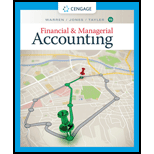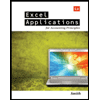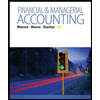
1.
Prepare
1.
Explanation of Solution
Bonds: Bonds are long-term promissory notes that are represented by a company while borrowing money from investors to raise fund for financing the operations.
Bonds Payable: Bonds payable are referred to long-term debts of the business, issued to various lenders known as bondholders, generally in multiples of $1,000 per bond, to raise fund for financing the operations.
Premium on bonds payable: It occurs when the bonds are issued at a high price than the face value.
Prepare journal entry for cash proceeds from the issuance of the bonds on July 1, 20Y1.
| Date | Account Title and Explanation | Post Ref | Debit ($) | Credit ($) | |||
| 20Y1 | Cash | 31,951,110 | |||||
| July | 1 | Premium on Bonds Payable (1) | 1,951,110 | ||||
| Bonds Payable | 30,000,000 | ||||||
| (To record issue of bonds at premium) | |||||||
Table (1)
- Cash is an asset and it is increased. So, debit it by $31,951,110.
- Premium on Bonds Payable is an adjunct liability account and it is increased. So, credit it by $1,951,110.
- Bonds payable is a liability and it is increased. So, credit it by $30,000,000.
Working note (1):
Calculate premium on bonds payable.
2. a.
Prepare journal entry to record first semiannual interest payment and amortization of bond premium on December 31, 20Y1.
2. a.
Explanation of Solution
Prepare journal entry for first semiannual interest payment and amortization of premium on bonds.
| Date | Account Title and Explanation | Post Ref | Debit ($) | Credit ($) | |||
| 20Y1 | Interest Expense (4) | 1,402,444 | |||||
| December | 31 | Premium on Bonds Payable (2) | 97,556 | ||||
| Cash (3) | 1,500,000 | ||||||
| (To record first semiannual payment of interest on bonds) | |||||||
Table (2)
- Interest expense is an expense and it decreases the equity value. So, debit it by $1,402,444.
- Premium on Bonds Payable is an adjunct liability account and it is decreased. So, debit it by $97,556.
- Cash is an asset and it is decreased. So, credit it by $1,500,000.
Working note (2):
Calculate premium on bonds payable semiannually.
Working note (3):
Calculate the amount of cash paid.
Working note (4):
Calculate the interest expense on the bond.
2. b.
Prepare journal entry to record second interest payment and amortization of bond discount on June 30, 20Y2.
2. b.
Explanation of Solution
Prepare journal entry for second interest payment and amortization of discount on bonds.
| Date | Account Title and Explanation | Post Ref | Debit ($) | Credit ($) | |||
| 20Y2 | Interest Expense (4) | 1,402,444 | |||||
| June | 30 | Premium on Bonds Payable (2) | 97,556 | ||||
| Cash (3) | 1,500,000 | ||||||
| (To record second semiannual payment of interest on bonds) | |||||||
Table (3)
- Interest expense is an expense and it decreases the equity value. So, debit it by $1,402,444.
- Premium on Bonds Payable is an adjunct liability account and it is decreased. So, debit it by $97,556.
- Cash is an asset and it is decreased. So, credit it by $1,500,000.
3.
Determine the amount of total interest expense for 20Y1.
3.
Explanation of Solution
Determine the amount of total interest expense for 20Y1.
Hence, the amount of total interest expense for 20Y1 is $1,402,444.
4.
Explain the situation when contract rate of bond is greater than the market rate of interest.
4.
Answer to Problem 2PA
Yes, the bond proceeds will always be greater than the face amount of bonds when the contract interest rate is greater than the market interest rate.
Explanation of Solution
If the stated interest rate of a bond is greater than the market interest rate, then the bonds is issued at premium. This is because the bonds is more valuable in market and investors is ready to pay more than the maturity
5.
Calculate the amount of cash proceeds (present value) from the sale of the bonds using present value tables.
5.
Explanation of Solution
Determine the amount of cash proceeds (present value) from the sale of the bonds.
Step 1: Calculate the semiannual interest on bonds.
Step 2: Calculate the present value of interest.
| Particulars | Amount |
| Interest payment (a) | $1,500,000 |
| PV annuity factor at semiannual market interest rate of 4.5% for 20 periods (b) | 13.00794 |
| Present value | $19,511,910 |
Table (4)
Note: Refer Appendix A in the text book for present value annuity factor.
Step 3: Calculate the present value of lump sum payment of $30,000,000 (principal amount) at 4.5% for 20 periods.
| Particulars | Amount |
| Single payment (a) | $30,000,000 |
| PV factor of $1 at semiannual market interest rate of 4.5% for 20 periods (b) | 0.41464 |
| Present value | $12,439,200 |
Table (5)
Note: Refer Appendix A in the text book for present value of $1 factor.
Step 4: Calculate the amount of cash proceeds from the sale of the bonds.
Thus, the amount of cash proceeds from the sale of the bonds is $31,951,110.
Want to see more full solutions like this?
Chapter 11 Solutions
Financial and Managerial Accounting - CengageNow
- Can you help me solve this general accounting question using the correct accounting procedures?arrow_forwardCan you help me solve this general accounting question using valid accounting techniques?arrow_forwardHello tutor please given General accounting question answer do fast and properly explain all answerarrow_forward
- I need guidance in solving this financial accounting problem using standard procedures.arrow_forwardI am trying to find the accurate solution to this general accounting problem with appropriate explanations.arrow_forwardPlease provide the solution to this general accounting question with accurate financial calculations.arrow_forward
- I need guidance with this general accounting problem using the right accounting principles.arrow_forwardHow can I solve this financial accounting problem using the appropriate financial process?arrow_forwardTransactions: Dec. 3 Wrote off Langston Corporation’s past-due account as uncollectible, $645.75. M203. 9 Accepted a 90-day, 8% note from Farris Company for an extension of time on its account, $2,400.00. NR23. 18 Received cash from Storage Solutions for the maturity value of NR19, a 90-day, 9% note for $2,000.00. R455. 21 Coastal Supply dishonored NR21, a 90-day, 8% note, for $3,000.00. M245. 30 Received cash in full payment of Langston Corporation’s account, previously written off as uncollectible, $645.75. M232 and R463. Task 1 Journalize the transactions for Miller Corporation in Questions Assets that were completed during December of the current year. Use page 12 of the general journal and page 12 of the cash receipts journal. Task 2 Post each entry to the general ledger and to the customer accounts in the accounts receivable ledger. You will not need to make entries to the Item columns of the ledgers. Task 3 Continue to…arrow_forward
 College Accounting, Chapters 1-27AccountingISBN:9781337794756Author:HEINTZ, James A.Publisher:Cengage Learning,
College Accounting, Chapters 1-27AccountingISBN:9781337794756Author:HEINTZ, James A.Publisher:Cengage Learning, Excel Applications for Accounting PrinciplesAccountingISBN:9781111581565Author:Gaylord N. SmithPublisher:Cengage LearningPrinciples of Accounting Volume 1AccountingISBN:9781947172685Author:OpenStaxPublisher:OpenStax College
Excel Applications for Accounting PrinciplesAccountingISBN:9781111581565Author:Gaylord N. SmithPublisher:Cengage LearningPrinciples of Accounting Volume 1AccountingISBN:9781947172685Author:OpenStaxPublisher:OpenStax College Financial AccountingAccountingISBN:9781305088436Author:Carl Warren, Jim Reeve, Jonathan DuchacPublisher:Cengage Learning
Financial AccountingAccountingISBN:9781305088436Author:Carl Warren, Jim Reeve, Jonathan DuchacPublisher:Cengage Learning Cornerstones of Financial AccountingAccountingISBN:9781337690881Author:Jay Rich, Jeff JonesPublisher:Cengage Learning
Cornerstones of Financial AccountingAccountingISBN:9781337690881Author:Jay Rich, Jeff JonesPublisher:Cengage Learning Financial & Managerial AccountingAccountingISBN:9781285866307Author:Carl Warren, James M. Reeve, Jonathan DuchacPublisher:Cengage Learning
Financial & Managerial AccountingAccountingISBN:9781285866307Author:Carl Warren, James M. Reeve, Jonathan DuchacPublisher:Cengage Learning





